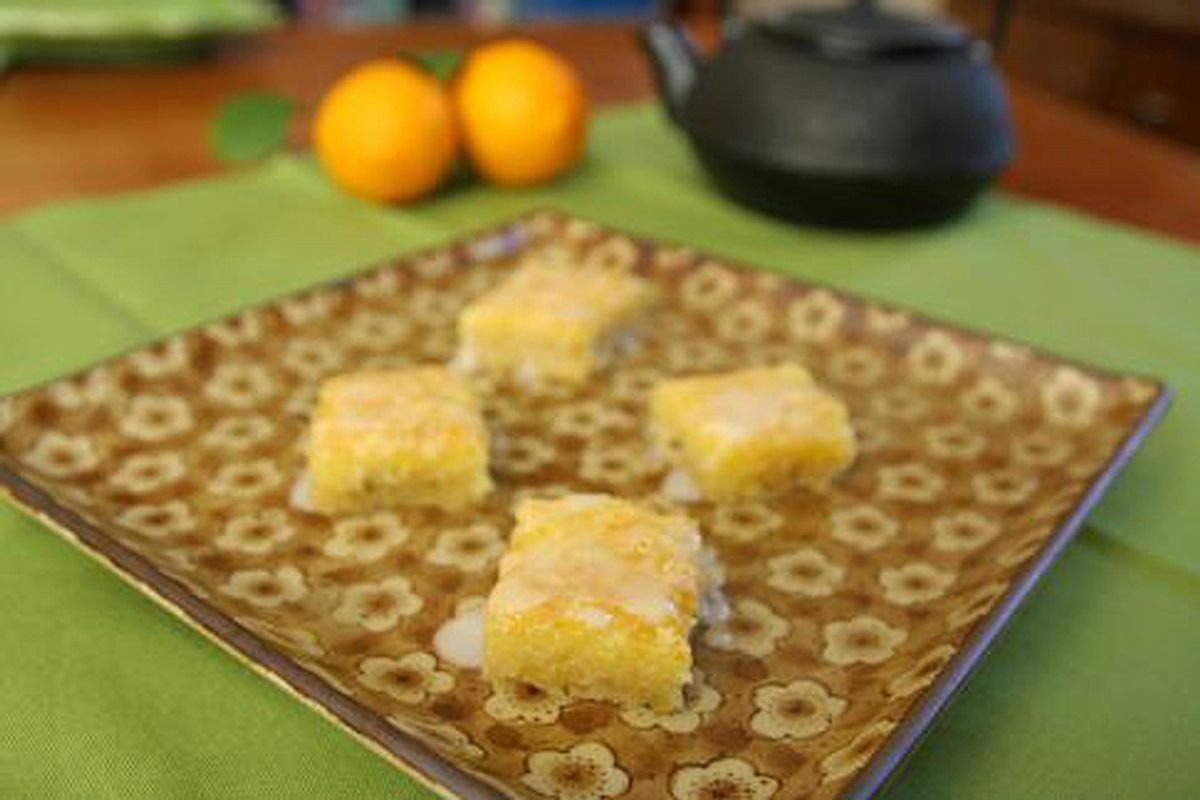Early February has been unseasonably warm in the Silicon Valley; the sun is shining, and kids wear shorts and T-shirts to school. It's hard to believe that just a few weeks ago, temperatures were dipping below freezing at night and front lawns were crunchy with frost in the mornings. Even when winter is cold and gray in the Bay Area, there are little drops of sunshine in the form of citrus trees in yards, decorated with grapefruits you could pitch in a softball game or kumquats no bigger than a thumbnail. When the sun does pierce through the Northern California gray skies, it is often blindingly low on the horizon. Likewise, these homegrown citrus fruits can often come with a tang that will scare off all but the scurviest of sailors.
Enter the Meyer lemon. Native to China, this petite, thin-skinned variety is actually a cross between a lemon and a mandarin orange, giving it the perfect blend of acid and sugar. However, the delicate rind and high sugar content make for poor shipping and storage, and the Meyer has never caught on as a supermarket item. Pricey in gourmet stores and farmer's markets, the best way to obtain them is by knowing someone.
It's not too hard in the Bay Area, as just about anyone with a yard owns a citrus tree, and when the harvest comes in full and fast, owners can't give them away quickly enough. I've found baskets of Meyers next to the coffee and doughnuts at church, and I've been handed bags of them at school pickup.
But not all Meyer lemons are created equal. Some have the lighter coloring of the standard Eureka lemon, or the thicker pith of a monstrous Ponderosa lemon. And they are not easy to grow. At least my tree hasn't been. Planted three years ago, it is still shorter than I. Newer branches sprout inch-long thorns making it hard to check for fruit. Not that there's been any -- until this winter. For the first time, my Meyer lemon tree bore fruit: three of them, in fact.
As I asked around, I learned that other people had difficulties getting new Meyer lemon trees to grow. They are sort of hothouse flowers. During the 1960s, nearly all of California's commercial Meyer lemon crop was wiped out by a Tristeza virus, and the remaining orchards were destroyed to avoid contaminating other trees. Growers at Four Winds Nursery found a disease-free strain, and in 1975 released the improved Meyer lemon tree for sale.
My friend Mary has a giant Meyer lemon tree in her backyard. The canopy towers over both of us and is filled with more yellow fruit than she can ever pick. Given the size of the tree and the fact that the house dates to the 1930s, it's safe to assume that this Meyer lemon is a survivor of the original strain. These "heirloom" Meyers appeal to me greatly. Their color is deeper, the rind thinner, the juice sweeter.
While I may doubt the improvements to the Meyer lemon tree, I have found a way to put a new spin on one of my favorite baked goods: the lemon bar. The Meyer lemon's fruit is not its only appeal. When the trees are in bloom, during late fall and early winter, its purple-tinged white flowers give off a heady fragrance reminiscent of jasmine on a summer evening. I've upped the lemon juice and zest content of the filling and incorporated jasmine green tea into the shortbread crust of the traditional recipe, to create the new and improved Meyer Lemon Bar!
Jasmine Tea and Meyer Lemon Bars
Ingredients
Crust
- 1 cup flour
- ¼ cup powdered sugar
- ½ cup unsalted butter
- ½ teaspoon jasmine tea
Filling:
- 2 tablespoons flour
- ¾ cup sugar
- ½ teaspoon baking powder
- 2 eggs
- 3 tablespoons Meyer lemon juice
- 2-3 teaspoons grated Meyer lemon zest (or more, if your lemon yields it)
Glaze:
- 1 teaspoon jasmine tea
- 4 tablespoons powdered sugar
Directions
- Butter a 9-inch square baking pan.
- Using a chef's knife and a rocking motion, mince the jasmine tea leaves.
- Cut the butter into small pieces. Add flour, sugar. When the mixture looks like coarse crumbs, mix in jasmine tea.
- Press the crust mixture into the baking pan.
- Bake in 350-degree oven for about 15 minutes.
- While crust is baking, make the filling: mix the dry ingredients in a bowl.
- Lightly beat the eggs, adding lemon juice and lemon zest.
- Add dry ingredients from Step 6.
- As soon as the crust is golden brown, pour the filling over it and return to oven. Bake 25 minutes longer, or until the top is mostly set.
- Make the glaze: steep the jasmine tea in one cup hot water. Strain the leaves, and add the brewed tea one spoonful at a time into the powdered sugar, stirring to make a glaze consistency.
- Run a thin, sharp knife around the outer rim of the pan as lemon bars are cooling. Drizzle with glaze and cut into 16 squares.



Shares